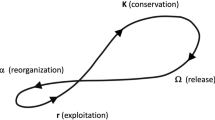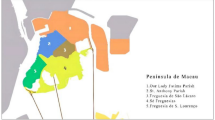Abstract
The colonial settlement of South Carolina in the 18th century resulted in the emergence of two largely separate economies, the organization of which gave rise to distinctive frontier landscapes. The commercial rice economy of the Lowcountry was characterized by dispersed plantation production facilitated by riverine transportation. The urban functions of this largely rural landscape were centered on entrepôt of Charleston, a city whose size and material wealth reflected the region’s commercial success. The Backcountry initially lacked access to the entrepôt’s urban and export markets and its regional isolation fostered insular economic institutions dispersed among smaller nucleated settlements linked by overland routes. Commercial investment by Charleston interests eventually established the infrastructure of specialized production in the Backcountry and incorporated its resources in the larger export economy. The settlement system that emerged in the interior reflected these changes, but did not emulate the Lowcountry. Rather, it bore the imprint of the frontier landscape, components of which merely acquired new roles as regional nodes in South Carolina’s expanding economy, the focus of which remained the older entrepôt that emerged as the South’s major port in the post-frontier period.
Similar content being viewed by others
References
Albion, Robert Greenhalgh 1939 The Rise of New York Port, 1815–1860. Reprinted 1970. Charles Scribner’s Sons, New York.
Baldwin, Robert E. 1956 Patterns of Development in Newly-Settled Regions. Manchester School of Social and Economic Studies 24:161–179.
Barr, William B. 1994 Ferry Crossings and Transportation Systems: Their Political, Economic, and Social Role in South Carolina’s Social Development. Underwater Archaeology Proceedings from the Society for Historical Archaeology Conference 1994, R. Woodward, editor, pp. 88–93. Vancouver, BC.
Bernheim, G. D. 1872 History of the German Settlements and of the Lutheran Church in North and South Carolina. Reprinted 1972. The Reprint Co., Spartanburg, SC.
Berry, Brian J. L. 1967 Geography of Market Centers and Retail Distribution. Prentice-Hall, Englewood Cliffs, NJ.
Brown, Richard Maxwell 1963 The South Carolina Regulators. Belknap Press of the Harvard University Press, Cambridge, MA.
Calhoun, Jeanne A., Martha A. Zierden, and Elizabeth A. Paysinger 1985 The Geographic Spread of Charleston’s Mercantile Community, 1732–1767. South Carolina Historical Magazine 86:182–220.
Casagrande, Joseph B., Stephen I. Thompson, and Philip D. Young 1964 Colonization as a Research Frontier. In Process and Pattern in Culture, Essays in Honor of Julian Η. Steward, Robert A. Manners, editor, pp. 281–325. Aldine, Chicago.
Catesby, Mark 1977 Mark Catesby’s Natural History, 1731–47. In The Colonial South Carolina Scene: Contemporary Views, 1697–1774, H. Roy Merrens, editor, pp. 87–109. University of South Carolina Press, Columbia.
Cronon, William 1991 Nature’s Metropolis, Chicago and the Great West. W. W. Norton, New York.
Earle, Carville, and Ronald Hoffman 1976 Staple Crops and Urban Development in the Eighteenth-Century South. Perspectives in American History 10:7–80.
Ernst, Joseph K., and H. Roy Merrens 1973 “Camden’s Turrets Pierce the Skies”: The Urban Process in the Southern Colonies. William and Mary Quarterly 3d Ser. 30:549–574.
Ferguson, Leland 1991 Lowcountry Plantations, the Catawba Nation, and River Burnished Pottery. In Studies in South Carolina Archaeology: Essays in Honor of Robert L. Stephenson, Albert C. Goodyear III and Glen T. Hanson, editors, pp. 185–191. South Carolina Institute of Anthropology and Archaeology, University of South Carolina, Anthropological Papers 9. Columbia.
Fischer, David Hackett 1989 Albion’s Seed: Four British Folkways in America. Oxford University Press, Oxford, England.
Greene, Jack P. 1987 Colonial South Carolina and the Caribbean Connection. South Carolina Historical Magazine 88:192–210.
Gregg, Alexander 1867 History of the Old Cheraws. Reprinted 1991. Southern Historical Press, Greenville, SC.
Groover, Mark D. 1994 Evidence for Folkways and Cultural Exchange in the Eighteenth Century South Carolina Backcountry. Historical Archaeology 28(1):41–64.
Hammond, Bray 1957 Banks and Politics in America: from the Revolution to the Civil War. Princeton University Press, Princeton, NJ.
Howe, George 1870 History of the Presbyterian Church in South Carolina. Duffie & Chapman, Columbia, SC.
Kirkland, Thomas J., and Robert M. Kennedy 1905 Historic Camden, Vol. 1, Colonial and Revolutionary. State Printing Co., Columbia, SC.
Klein, Rachel 1981 Ordering the Backcountry: The South Carolina Regulation. William and Mary Quarterly 3d Ser. 38:661–680.
Kovacik, Charles F., and John J. Winberry 1987 South Carolina: A Geography. Westview Press, Boulder, CO.
Kulikoff, Allan 1993 Households and Markets: Toward a New Synthesis of American Agrarian History. William and Mary Quarterly 3d Ser. 50:342–355.
Lewis, Kenneth E. 1976 Camden: A Frontier Town in Eighteenth Century South Carolina. South Carolina Institute of Anthropology and Archaeology, University of South Carolina, Anthropological Studies 2. Columbia.
1977 A Functional Study of the Kershaw House Site in Camden, South Carolina. South Carolina Institute of Anthropology and Archaeology, University of South Carolina, Research Manuscript Series 110. Columbia.
1984 The American Frontier, an Archeological Study of Settlement Pattern and Process. Academic Press, Orlando, FL.
MacGill, Caroline 1917 History of Transportation in the United States before 1860. Reprinted 1948. Peter Smith, New York.
McCusker, John J., and Russell R. Menard 1985 The Economy of British America, 1607–1789. Published for the Institute of Early American History and Culture by University of North Carolina Press, Chapel Hill.
Menard, Russell R. 1994 Financing the Lowcountry Export Boom: Capital and Growth in Early South Carolina. William and Mary Quarterly, 3d Ser. 51:659–676.
Meriwether, Robert L. 1940 The Expansion of South Carolina. Southern Publishers, Kingsport, TN.
Merrens, H. Roy 1964 Colonial North Carolina in the Eighteenth Century, a Historical Geography. University of North Carolina Press, Chapel Hill.
Moore, John Hammond 1993 Columbia and Richland County: A South Carolina Community, 1740–1990. University of South Carolina Press, Columbia.
Nettels, Curtis P. 1962 The Emergence of a National Economy, 1775–1815, Vol. 2, The Economic History of the United States. Holt, Rinehart and Winston, New York.
Nobles, Gregory H. 1989 Breaking into the Backcountry: New Approaches to the Early American Frontier. William and Mary Quarterly, 3d Ser. 46:641–670.
Petty, Julian J. 1943 The Growth and Distribution of Population in South Carolina. Reprinted 1973. The Reprint Co., Spartanburg, SC.
Price, Jacob M. 1974 Economic Function and the Growth of American Port Towns in the Eighteenth Century. Perspectives in American History 8:123–186.
Ramsey, David 1858 Ramsey’s History of South Carolina. Reprinted 1960. The Reprint Co., Spartanburg, SC.
Richardson, Katherine H. 1993 The Impact of the Township System on the Backcountry of South Carolina: From Garrison Towns to “Traditional” Towns. Paper presented at the Southern Colonial Backcountry Conference, Columbia, SC.
Rogers, George C., Jr. 1969 Charleston in the Age of the Pinckneys. University of Oklahoma Press, Norman.
Schulz, Judith Jane 1972 The Rise and Decline of Camden as South Carolina’s Major Inland Trading Center, 1751–1829: A Historical Geographical Study. M.A. thesis, Department of Geography, University of South Carolina, Columbia.
Sellers, Leila 1934 Charleston Business on the Eve of the American Revolution. University of North Carolina Press, Chapel Hill.
Steffen, Jerome O. 1979 Insular vs. Cosmopolitan Frontiers: A Proposal for Comparative Frontier Studies. In The American West: New Perspectives, New Dimensions, Jerome O. Steffen, editor, pp. 94–123. University of Oklahoma Press, Norman.
Stumpf, Stuart O. 1983 South Carolina Importers of General Merchandise, 1735–1765. South Carolina Historical Magazine 84:1–10.
Taylor, George Rogers 1951 The Transportation Revolution, 1815–1860, Vol. 4, The Economic History of the United States. Rinehart and Co., New York.
Terry, George D. 1981 “Champaign Country”: A Social History of an Eighteenth Century Lowcountry Parish in South Carolina, St. Johns Berkeley County. Ph.D. dissertation, Department of History, University of South Carolina, Columbia. University Microfilms International, Ann Arbor, MI.
Thorp, Daniel B. 1991 Doing Business in the Backcountry: Retail Trade in Colonial Rowan County, North Carolina. William and Mary Quarterly 3d Ser. 48:387–408.
Townsend, Leah 1935 South Carolina Baptists, 1670–1805. Reprinted 1974. The Reprint Co., Spartanburg, SC.
Yentsch, Anne 1991 Chesapeake Artefacts and Their Cultural Context: Pottery and the Food Domain. Post-Medieval Archaeology 25:25–72.
Author information
Authors and Affiliations
Rights and permissions
About this article
Cite this article
Lewis, K.E. The metropolis and the backcountry: The making of a colonial landscape on the South Carolina frontier. Hist Arch 33, 3–13 (1999). https://doi.org/10.1007/BF03373619
Published:
Issue Date:
DOI: https://doi.org/10.1007/BF03373619




